Categories
Select a new category
CDC Data Show Increase in Autism Diagnosis
By Chelsea Toledo, M.A. on May 9, 2018
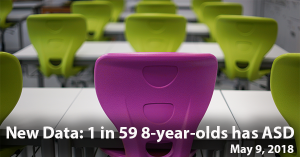
Background: The U.S. Centers for Disease Control and Prevention, or CDC, regularly monitors communities to make estimates of the prevalence of Autism Spectrum Disorder (ASD) among children across the country. In 2016, the CDC estimated ASD prevalence of one in 68 for 8-year-olds based on data collected from 2010 to 2012. Prior to that, the prevalence among 8-year-olds was estimated to be one in 150.
What’s New: The latest CDC data – collected in 2014 – provide a new estimate for the prevalence of ASD among 8-year-old children: one in 59. To arrive at this figure, the researchers reviewed the records of more than 300,000 children in 11 states.
The researchers found:
- The overall prevalence of ASD in 2014 was 16.8 per 1,000 – or one in 59 – in the sites surveyed.
- That proportion provides a rough estimate for autism prevalence in the country; however, the results are not entirely generalizable as they come from only 11 sites.
- The median age at which members of the sample group received an ASD diagnosis was 4 years and 4 months – down slightly from 4 years and 5 months in previous years.
- The ratio of boys to girls receiving ASD diagnoses decreased slightly – from 4.5:1 in 2002-2012 to 4:1 in 2014.
- While white children continue to have higher rates of ASD diagnoses than their black and Hispanic peers, that difference became less pronounced in 2014.
Why it’s important: The continued increase in ASD prevalence among children raises a major concern for clinicians and researchers alike. However, the leveling of diagnosis rates among various groups – boys versus girls, white versus minority children – suggests that ASD diagnosis may be improving among previously underrepresented groups. Further surveillance is needed to determine the factors contributing to ASD prevalence increases.
Help me understand :
| Source(s) : |
| Tweet |
Lost Diagnoses May Affect Autism Prevalence Estimates
By Chelsea E. Toledo, M.A. on December 30, 2015
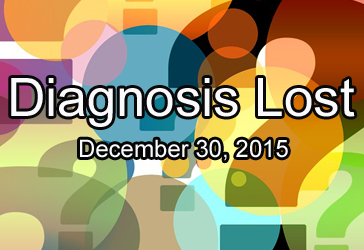
Background: The U.S. Centers for Disease Control and Prevention estimates that 1 in 68 American children has autism spectrum disorder (ASD), a number based on nation-wide surveys and the review of medical and/or educational records. When public health professionals update survey design, the estimated autism prevalence often shifts to a different number. The actual prevalence is less defined than it may seem.
What’s New: On October 20, 2015, the journal Autism published a study exploring the possibility that estimates of ASD’s prevalence may be influenced by “lost diagnoses” – meaning that experts count children who previously had a diagnosis for autism that was later reconsidered. The researchers compared national survey data and retrospective parental interviews from 1420 children between the ages of 6 and 17 with ASD against those from 187 of their peers who had lost their diagnoses.
They found that about one in eight children ever diagnosed with ASD eventually lost the diagnosis, and that three-fourths of those diagnoses changed based on new information from doctors. According to the parental interviews, other reasons included:
- Initial diagnosis of ASD enabled the child to receive needed services, but the child never had ASD
- Treatment helped the condition go away
- Misdiagnosed after not testing properly
- Disagreement with the doctor’s diagnosis
Children with lost diagnoses were less likely to have parents concerned early on about their communication, behavior and social abilities, and were also less likely to have received their initial diagnosis from an ASD specialist.
Why it’s important: This study highlights the imprecise nature of autism estimates by pointing out several reasons for a lost ASD diagnosis. Future research could determine whether diagnoses made by non-specialists are overinflating the estimates of ASD prevalence.
Help me understand :
| Source(s) : |
| Tweet |
Survey Redesign Raises ASD Prevalence Estimate
By Shana R. Spindler, Ph.D. on December 1, 2015
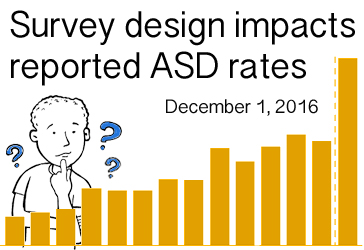
Background: The National Health Interview Survey (NHIS) is a national, parent-reported household survey, which includes questions about lifetime autism spectrum disorder (ASD) diagnosis. For several years, the NHIS reported a lower rate of ASD in the United States compared to other major surveys at the time. To what extent survey design, wording, and presentation affect the reporting of ASD diagnosis is an important area of investigation.
What’s new: Survey question wording and order have a significant impact on report rates for ASD, according to a new National Health Statistics Report. Researchers compared the ASD rate between the 2011-2013 NHIS and the 2014 NHIS, which included several changes in questions related to ASD. The 2014 survey included a stand-alone question about ASD diagnosis placed before questions about other developmental disabilities, and the survey language included terminology such as autism, Asperger’s disorder, and pervasive developmental disorder. With these changes, the reported ASD rate climbed from 1 in 80 to 1 in 45 for children ages 3 to 17 years. The 2014 survey included approximately 13,000 participants.
Why it’s important: This study highlights the importance of survey design for accurate estimates of ASD prevalence. Based on the short time period between the 2011-2013 and 2014 surveys, the authors state that an environmental factor is unlikely to have caused the dramatic increase in ASD prevalence between the two surveys.
Help me understand :
| Source(s) : |
| Tweet |
CDC Reports ASD Rate Now 1 in 68
By Shana R. Spindler, Ph.D. on March 28, 2014
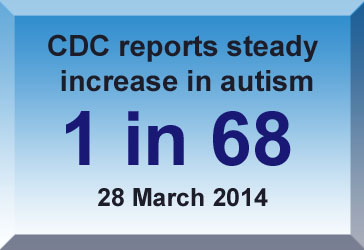
Background: Every few years, the United States Centers for Disease Control and Prevention (CDC) monitors the rate of Autism Spectrum Disorder (ASD) across the country. Participants in the CDC-funded Autism and Developmental Disabilities Monitoring (ADDM) Network collect data on 8-year-old children from a sampling of United States communities. In 2007, they published their first report, which showed that about 1 in 150 children had ASD. Since then, the rate has made a steady climb. In 2009, the number rose to 1 in 110. This was followed by 1 in 88 with ASD in the 2012 report.
What’s New: The CDC now reports that approximately 1 in 68 children in the United States have some form of ASD. The rate of ASD varies by community, with rates as low as 1 in 175 children in Alabama, contrasted to 1 in 45 in New Jersey. Of note, nearly half of the children with ASD had average or above average intellectual ability (IQ greater than 85), as compared to only 32 percent in 2002.
Why it’s important: Population-based studies are an important component of estimating ASD rates. It’s difficult to pinpoint why ASD rates are steadily increasing in the United States. Several factors may be at work, such as better detection methods, increased autism awareness, or environmental influences.
Help me understand :
| Source(s) : |
| Tweet |
UK Autism Rates Stabilize from 2004 to 2010
By Shana R. Spindler, Ph.D. on November 5, 2013
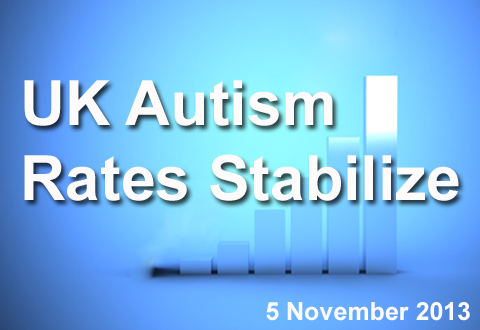
Background: In several countries around the world, autism rates rose dramatically in the 1990s. In March 2012, the United States Centers for Disease Control (CDC) released results from a long-term study indicating that U.S. autism rates continued to rise—by about 78 percent—between the years 2004 and 2008. This publication prompted U.S. and United Kingdom researchers to explore autism rates in the U.K. for the same time period.
What’s new: On October 16, 2013, the online journal BMJ Open published a population-based study that looked at autism rates in the U.K. from 2004 to 2010 in 8-year-old children. Using the U.K. General Practice Research Database (GPRD), researchers found that autism prevalence remained stable during those years, even after the dramatic increase during the 1990s. Newly diagnosed cases also reached a plateau, with an average of 1.2 per 1000 boys and .23 per 1000 girls diagnosed per year across the seven years examined.
Why it’s important: While U.S. rates have continued to climb over the past decade, U.K. rates have appeared to stabilize. Compared to the CDC’s estimate of one in 54 boys and 1 in 252 girls with autism in the U.S., the current study suggests a lower prevalence in the U.K. at 3.8 in 1000 boys and .8 in 1000 girls. It’s important to note that differences in diagnostic criteria and study methodology may contribute to these discrepancies.
Help me understand :
| Source(s) : |
| Tweet |
Paternal Age and Autism Link Holds Up in Aruba
By Chelsea Toledo, M.A. on September 28, 2012
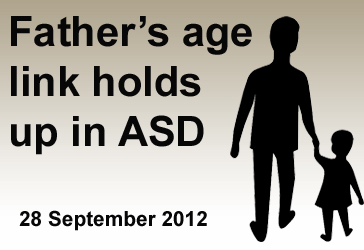
Background: Several major studies have demonstrated that children with Autism Spectrum Disorder (ASD) are more likely to be born to older fathers. However, the majority of that research has been carried out in high-income countries such as the United States, Western Australia and the United Kingdom. Research in less industrialized settings could shed light on the level to which social and cultural factors contribute to the prevalence of ASD within a geographical area.
What’s New: In the September 2012 version of PLOS ONE, researchers report that Aruban children with ASD are more than twice as likely to have been born to a father over age 30 than their peers without the disorder. Studying publically available medical records, they determined that the risk of having a child with ASD was about twice as high for fathers in their thirties and two and a half time as high for fathers in their forties than the risk for younger fathers. These findings are consistent with those from more industrialized nations and demonstrate that the link between paternal age and risk for ASD is present in a country with lower income, where the economy and demographics are in transition.
Why it’s important: While it is understood that the risk of having an autistic child increases with the age of the father, the explanation for that association is not yet clear. Because fathers in Aruba have diverse reasons for delayed parenting, the study effectively rules out the theory that men with unperceivable autism tend to have children later and pass on those genes.
Help me understand :
| Source(s) : |
| Tweet |
Autism Associated with Family Mental Health History
By Chelsea E. Toledo, M.A. on September 13, 2012
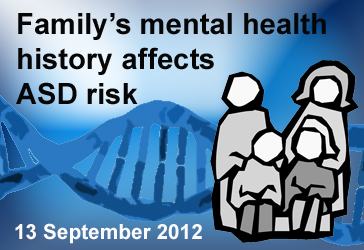
Background:
Until the 1980s, Autism Spectrum Disorder (ASD) was commonly diagnosed as childhood schizophrenia. Although ASD and schizophrenia are now regarded as distinct, common causal factors—such as genetic variations—can contribute to either condition, as well as to bipolar disorder.
What’s New:
In the 2 July 2012 online edition of the journal Archives of General Psychiatry, researchers report that ASD appears more frequently in people whose parents or siblings have been diagnosed with schizophrenia or bipolar disorder. The researchers studied over 30,000 medical records from Sweden and Israel and found that ASD was three times more likely to occur in people whose parents had a schizophrenia diagnosis. For people whose siblings had schizophrenia, ASD appeared 2.5 times more often in the Swedish group and 12 times more often in the group from Israel. In the entire sample, ASD was about twice as likely to occur when either a sibling or a parent was diagnosed with bipolar disorder.
Why it’s important:
The understanding of ASD’s cause remains incomplete. By studying factors that make ASD more common in some families than in others, researchers gain greater knowledge of the disorder’s etiology.
Help me understand :
| Source(s) : |
| Tweet |
Poor Transitions for High School Graduates with Autism
By Catherine Croft Swanwick, Ph.D. on May 14, 2012
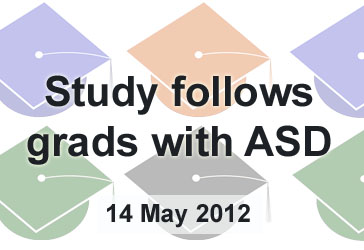
Background: Youth diagnosed with Autism Spectrum Disorders (ASD) are at high risk for unemployment and lack of post secondary education, according to a national study published recently in the journal Pediatrics. In the largest study of its kind yet, scientists analyzed outcomes for ASD youth using data generated from the National Longitudinal Transition Study 2 (NLTS2), a 10-year prospective study of youth receiving special education services conducted by SRI International for the U.S. Department of Education.
What’s New: In the six years immediately following high school, only 34.7% of youth with ASD had attended college and merely 55.1% had held paid employment. ASD youth with higher functional ability showed better outcomes, as did those from higher income families. However, overall the ASD youth exhibited significantly lower percentages than youth with other special needs, such as speech/language impairment (51.0% college, 86.0% employment), learning disability (39.9% college, 93.8% employment), or mental retardation (18.2% college, 68.9% employment).
Why It’s Important: What could be causing these poor outcomes? Signs point to problems with the transitional period after high school. In the first two years following high school, more than half of ASD youth (51.9%) were unemployed and not enrolled in college, whereas this percentage lowered dramatically to 11.1% when ASD youth had exited school at least four years ago. Together, this study recommends improved transition planning for ASD youth before they graduate from high school.
Help me understand :
| Source(s) : |
| Tweet |
Autism Prevalence in U.S. Rises to 1:88
By Catherine Croft Swanwick, Ph.D. on March 29, 2012
Overview: The Centers for Disease Control and Prevention (CDC) announced 1:88 as their latest estimate for prevalence of Autism Spectrum Disorders (ASD) in the United States, as determined by the Autism and Developmental Disabilities Monitoring (ADDM) Network.
Background: Launched in 2000, the ADDM Network includes sites across the U.S. that track the number of children with ASD by screening children’s health and education records.
What’s New: The latest estimate of 1:88 captures the number of 8 year old children with ASD as of the year 2008, as gathered by 14 ADDM state sites (AL, AZ, CO, GA, MD, MO, NC, PA, SC, WI, FL, AR, NJ, UT). This ratio shows a sharp rise from the CDC’s previous estimate of 1:110, as determined by ADDM Network data gathered in 2006.
Why It’s Important: Debate exists as to whether the higher ASD estimate actually represents a true rise in prevalence or instead reflects increased ASD awareness and detection. Ongoing public health surveillance is needed to understand how such factors influence the ASD prevalence rate.
Help me understand :
| Source(s) : |
| Tweet |
Both Genetics and Environment Important in Autism
By Shana R. Spindler, Ph.D. on January 22, 2012
Overview: Autism susceptibility has a significant environmental component, according to a study published in the November issue of the Archives of General Psychiatry.
Background: Researchers from across California identified twin pairs with at least one twin having autism spectrum disorder (ASD) to investigate the relative influence of genes versus environment on the development of ASD. In total, the researchers examined 192 pairs of twins, including 54 identical twins and 138 fraternal twins, one of the largest studies of its kind.
What's New: The researchers completed a statistical analysis comparing the rate of autism diagnosis for identical versus fraternal pairs. Using their analysis, they estimated that 38 percent of ASD cases are due to genetic factors, and 58 percent are due to environmental factors. However, the study’s findings were not conclusive given that the statistical analysis did not take into account genetic susceptibility to the environment.
Why it's important: According to the report’s authors, future studies that examine the association between genetics and environment will likely enhance our understanding of autism.
Help me understand :
| Source(s) : |
| Tweet |
Research on Autism Physiology Increasing
By Shana R. Spindler, Ph.D. on January 11, 2012
Overview: A new review published in last month’s issue of Molecular Psychiatry highlights the fact that research efforts to study physiological abnormalities in autism are increasing.
Background: The authors of the study completed a literature search of papers published between 1971 and 2010 in four major areas of autism research, including immune system dysregulation, cellular oxidative stress, mitochondrial dysfunction, and environmental toxicant exposures.
What's new: The authors found that publication rates for studies that investigate the role of the immune system, cell function, and environmental toxins in the development of autism increased. In contrast, the publication rate for studies examining cellular damage in the brain or theory of mind have slowed or even decreased. Overall, the researchers found that genetic studies still remain the largest segment of autism research.
Help me understand :
| Source(s) : |
| Tweet |

